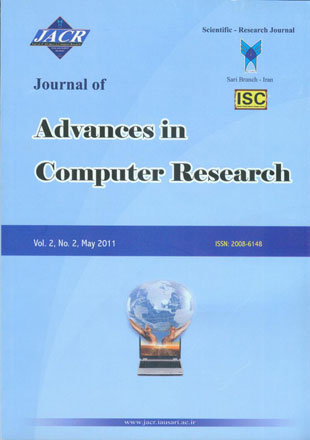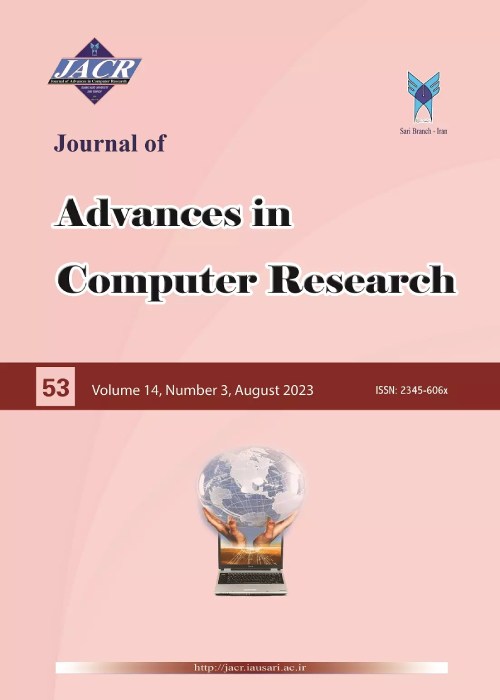فهرست مطالب

Journal of Advances in Computer Research
Volume:2 Issue: 2, Spring 2011
- 104 صفحه،
- تاریخ انتشار: 1391/02/01
- تعداد عناوین: 8
-
Pages 1-12Information integration plays an important role in academic environments since it provides a comprehensive view of education data and enables mangers to analyze and evaluate the effectiveness of education processes. However, the problem in the traditional information integration is the lack of personalization due to weak information resource or unavailability of analysis functionality. In this research the layered service-oriented framework was proposed which augmented recommendation approaches with components of semantic based integration to provide adaptive, flexible, and context based information integration and analysis for decision makers in Higher Education Institutes. This framework encompassed the integration of structured information from internal data sources as well as unstructured data from the Web. The main objective of this paper was to adapt the content as well as appropriate services for personalized information analysis. In addition, the framework could enable administrators to analyze instances of education information and receive recommendation of new information sources as well as web services based on the current education status. Service orientation paradigm provides adaptive, flexible, and scalable means of communication for service interoperability and interaction among the framework components. Semantic web technologies help to overcome the heterogeneity among information sources and facilitate on-demand web service discovery and invocation for efficient information analysis.
-
Pages 13-20In this paper a novel design of all-optical half-subtractor based on nonlinear directional coupler is proposed. By using four waveguides and appropriately adjusting the refractive indices and selecting the proper length of waveguides, halfsubtractor function can be obtained. The operation of this function is simulated by RSoft CAD-Layout (BeamPROP) simulator. The simulation results confirm the alloptical half-subtractor circuit without any optoelectronic conversions.
-
Pages 21-45Extensive researches on Wireless Sensor Networks (WSNs) have been performed and many techniques have been developed for the data link (MAC) layer. Most of them assume single-channel MAC protocols. In the usual dense deployment of the sensor networks, single-channel MAC protocols may be deficient because of radio collisions and limited bandwidth. Hence, using multiple channels can significantly improve the performance of WSN. Recent developments in sensor technology, as seen in Crossbow’s MICAz Mote, Rockwell’s WINS nodes and IEEE 802. 15. 4 Zigbee, have enabled support for multi-channel communications. Several multi-channel MAC protocols with different objectives have been proposed for WSNs in literature. This paper surveys and classifies the state-of-the-art multichannel MAC protocols that are proposed for WSNs. It first outlines the sensor network properties that are crucial for designing a MAC protocol. It subsequently reviews the existent challenges to design a good multi-channel MAC protocol for the sensor networks. Then, several multi-channel MAC protocols specifically proposed for the WSNs are inspected in detail and compared with each other. Finally, some open issues in this area are outlined for future research.
-
Pages 47-54One of the most fundamental features of digital image and the basic steps in image processing, analysis, pattern recognition and computer vision is the edge of an image where the preciseness and reliability of its results will affect directly on the comprehension machine system made objective world. Several edge detectors have been developed in the past decades, although no single edge detectors have been developed satisfactorily enough for all application. In this paper, a new edge detection technique was proposed based on the BP neural network. Here, the edge patterns of a quad-pixel in binary images were classified into 16 possible types of visual patterns. In the following, after training the pre-defined edge patterns, the BP neural network was applied to correspond any type of edges with their related visual patterns. Compared with traditional edge detection techniques, the results demonstrate that the new proposed technique, improved the computations mass and mathematical complexity, turns out better.
-
Pages 55-74Heretofore several position-based routing protocols have been developed for mobile ad hoc networks. Many of these protocols assume that a location service is available which provides location information on the nodes in the network.Our solutions decrease location update without loss of query success rate or throughput and even increase those.Simulation results show that our methods are effective and the algorithms are distributed and can keep scalability in scenario of increasing nodes density.
-
Pages 75-83One of the most important challenges in nonlinear, multi-input multi-output (MIMO) and time variant systems (e. g., robot manipulator) is designing a controller with acceptable performance. This paper focused on design a new artificial non linear controller with on line tunable gain applied in the robot manipulator. The sliding mode fuzzy controller (SMFC) was designed as 7 rules Mamdani’s inference system because it has one input as sliding function and one output as fuzzy sliding function which the integral part was added to the sliding function in the presence of uncertainties and external disturbance to reduce the limitations. Sliding mode controller (SMC) has two most important challenges in uncertain systems: chattering phenomenon and nonlinear dynamic equivalent part. Applying the sliding mode methodology to Mamdani’s fuzzy logic controller with minimum rules was the first goal that caused the stability development. Second target focused on the elimination of chattering phenomenon with regard to the variety of uncertainty and external disturbance in fuzzy sliding mode controller by on-line optimization the tunable gain.
-
Pages 85-96Security term in mobile ad hoc networks has several aspects because of the special specification of these networks. In this paper a distributed architecture was proposed in which each node performed intrusion detection based on its own and its neighbors’ data. Fuzzy-neural interface was used that is the composition of learning ability of neural network and fuzzy Ratiocination of fuzzy system as our architecture engine. Our scrutiny showed that fuzzy-neural interface had a good ability for separating normal data from abnormal. The ability of proposed architecture was evaluated in accuracy and overhead case.
-
Pages 97-104With the increase of the number of cameras installed across a video surveillance network, the ability of security staffs to attentively scan all the video feeds actually decreases. Therefore, the need for an intelligent system that operates as a tracking system is vital for security personnel to do their jobs well. Tracking people as they move through a camera network with non-overlapping field of view is a challenging issue. It requires re-identification of objects when they leaves one field of view and appears at another scene later. The appearance of the people is changed significantly among the cameras due to illumination changes, parameters of camera, viewing angle, and deformable geometry of people. Additionally the observations of people are often broadly separated in time and space and common proximity techniques can not be used to constrain possible correspondences. In this paper a new feature was proposed to represent the appearance of people, which is capable of dealing with the common illumination changes occurring in indoor environment. To produce the proposed feature, first the image was transformed to YCbCr color space. Then diagonal vectors of color co-occurrence matrix of each individual were extracted and normalized. Experimental results from a real surveillance scene showed the efficiency of the proposed method.


